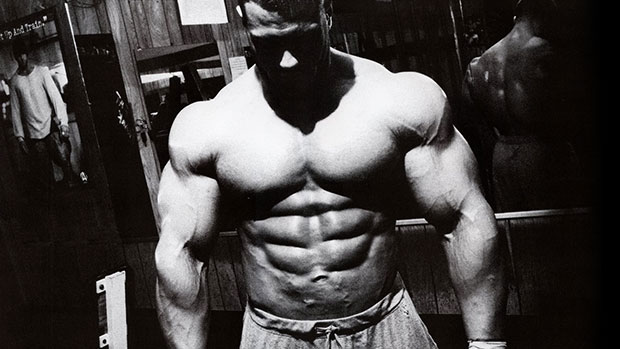Smallness is a Disease. Squats are the Cure.
Decades ago, the answer to almost every muscle-related question was, "squat."
- "How do I get my arms to grow?"
- "Squat."
- "How do I gain weight?"
- "Squat."
- "How do I get that pretty girl in my economics class to find me interesting?"
- "Squat."
Now when someone said, "If you want bigger arms, then squat" it didn't mean the squat itself would make your arms grow. You'd still need to do some curls and triceps work. The point was, squatting drives overall growth. It works as a catalyst for systemic (system wide) growth and complements all the pressing and pulling you can do.
All the pushdowns and concentration curls in the world aren't going to help you grow if there isn't systemic hypertrophy pushing your overall growth. And for the longest time, that's why the high-rep squat was praised.
There's a legendary old-school plan called Super Squats which claimed you could gain 30 pounds of muscle in 6 weeks through high-rep squatting. Now, the odds of that happening are about the same as winning the lottery. Nonetheless, working through six weeks of high-rep squats has value. If you haven't been doing high-rep squats, you'll see some significant increases in lean mass. As a bonus, you'll learn how to endure, and even appreciate, truly hard work.
If you're past the beginner stage, and you're looking for a simple way to pack on more muscle overall (and maybe fix those bird legs) then this program is for you. It's stupid-simple, yet highly intelligent.
- The plan is 6 weeks long.
- There are only 2 workouts, which you'll rotate throughout the weeks.
- You'll train only on Monday, Wednesday, and Friday. All other days are off.
So, since both workouts contain 20-rep squats, you'll be doing them three times per week. It's a minimalist-style program built around the basics, some progressive overload, and a metric ass-load of effort. Here's what it looks like:
Workout 1
- Bench Press – 3-4 warm-up sets, then 3 sets of 8 reps
- Squat – 3-4 warm-up sets, then 1 set of 20 reps
- Chest-Supported Row – 2-3 warm-up sets, then 3 sets of 12 reps
- Curl (any variation) – 2 warm-up sets, then 2 sets of 12 reps
Workout 2
- Incline Press – Do 3-4 warm-up sets, then the 3/50 method. That's 3 sets with the same weight, shooting for about 50 total reps over those three sets. A proper weight selection should have you hitting around 18 to 22 reps on the first set. Once you're able to get a total of 50 reps over 3 sets, add weight. An example for a strong lifter might look like this:
- 225 x 22
- 225 x 13
- 225 x 8
- Total reps = 43 (Close enough. Stick with that weight until you can get 50.)
- Squat – 3-4 warm-up sets, then 1 set of 20 reps
- Chin-up – 50 total reps in as few sets as possible. If you can't do a lot of chin-ups, then get stronger.
- Dip – 5 sets of 10 reps, using additional weight if needed
Week 1
- Monday: Workout 1
- Tuesday: Off
- Wednesday: Workout 2
- Thursday: Off
- Friday: Workout 1
- Saturday & Sunday: Off
Week 2
- Monday: Workout 2
- Tuesday: Off
- Wednesday: Workout 1
- Thursday: Off
- Friday: Workout 2
- Saturday & Sunday: Off
This pattern then repeats for 4 more weeks.

- On the first week of squatting, don't go in and kill yourself. If you do that the first session, you're probably going to be too sore to walk for a few days, much less squat again two days later. Each session, add a little bit of weight to the squat. By the second week you should be accustomed enough to them that you can really start adding on weight and upping the intensity. If you do this right, you should hit a 20-rep squat PR your last week.
- For all the other exercises, use progressive overload. Try to add weight and/or reps where you can. If you start light, and get a run-and-go in your planning, you should hit some PRs over the coming weeks in most of the movements.
- Don't start too heavy or get too crazy with your effort the first week. Think about each week building on progression for the upcoming week. This is smart and effective programming.
- You should also be really tired of doing 20-rep squats at that point after 6 weeks, and you'll be ready for a deload or a week off completely.
- Don't use this program while in a hypocaloric state, i.e. dieting. This is for the guy that really wants to build mass and push past plateaus. And those can't happen without a surplus of food to accommodate this training.
Don't do this program for more than 6 weeks without stopping to assess where you are physically and mentally. Squatting three times a week is rough. Do that for too long and you're going to end up with some overuse issues. Also, squatting for 20 reps will eventually take a toll on you mentally and you'll find it harder and harder to be up for a truly significant training session.
Be in tune with how you feel mentally each workout and each week. I call it the difference in being hungry and being full. When you get full, you don't want to eat another bite. Well, you can get full on training too. And that's defined by having thoughts of "I really don't want to be in here today."
That happens to all of us, and is not a loser's mentality, despite all the "hardcore" memes you see on the internet. I'm talking about guys and gals who are regulars, and not people who haven't established training as habit or found their love for it yet.
Be cognizant of mental burnout. When it happens for a few training sessions in a row, then take some time off. If you're smart and allow the intensity to build each week, that shouldn't happen over six weeks.
This kind of training and experience will pay dividends for years to come because it'll teach you a lot of invaluable lessons that can be applied throughout your training life each time you encounter a plateau. There are lessons that can only be learned in the trenches, and they take place most often inside a squat rack.





